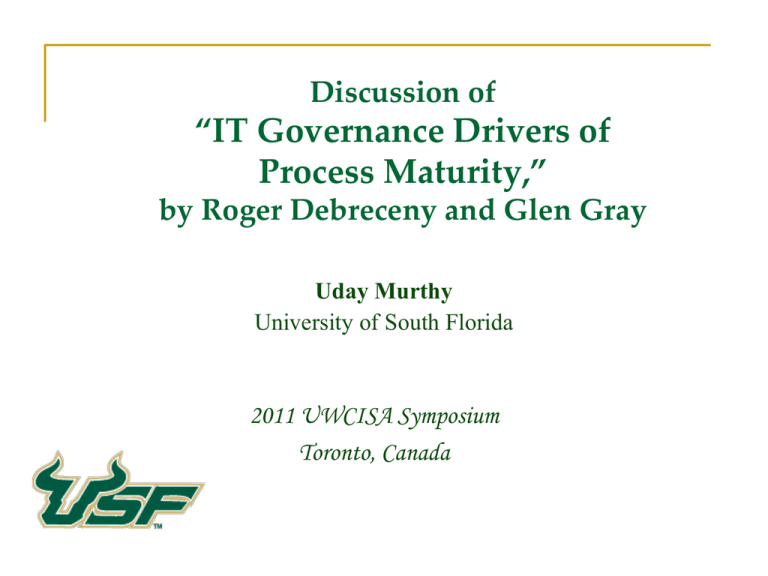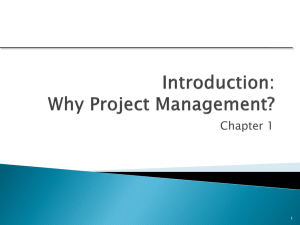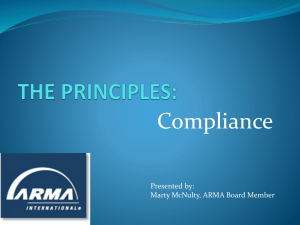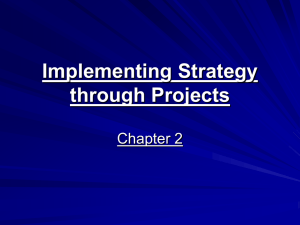Discussion-of-IT-governance-drivers-of-process-maturity
advertisement

Discussion of “IT Governance Drivers of Process Maturity,” by Roger Debreceny and Glen Gray Uday Murthy University of South Florida 2011 UWCISA Symposium Toronto, Canada Agenda Research questions Theoretical foundation Field study methodology IT governance drivers Process maturity measurement Analysis & results Contributions Unanswered questions….future directions 2 Research Questions Are there attributes of IT governance that govern the level of process maturity? If so, which attributes are more or less significant? Are there domains or processes that are more influential? Are there other control variables such as size or industry that explain the relationship between IT governance and process maturity? Is process maturity evenly distributed across domain? 3 Theoretical Foundation Resource Based View, Dynamic Capability Theory, Contingency Theory “…provide guidance on the relationship between governance, strategy and resource acquisition…” Unclear how these theories inform the relationship between IT governance and process maturity No propositions offered (as promised in intro) 4 Field Study Nice cross-section of location and industry in sample of 51 organizations Developed countries more heavily represented than developing countries Europe, Canada, US, Singapore: 76% Mexico, Philipines: 24% Mainly large firms (avg. of 172 IT personnel, 194 servers) 5 IT Governance Drivers Very comprehensive approach to data collection Decision rights and organization Governance framework (39!) Business/IT alignment (24 questions) Environmental volatility Size and complexity 6 Process Maturity -- What Generic maturity model (Fig. 13 in COBIT 4.1) vs. Maturity attribute table (Fig. 15 in COBIT 4.1) 7 8 Awareness and Communication 1 Recognition of the need for the process is emerging. Policies, Plans and Procedures There are ad hoc approaches to processes and practices. There is sporadic communication of the issues. 2 There is awareness of the need to act. The process and policies are undefined. Management communicates the overall issues. Management is more formal and structured in its communication. 4 There is understanding of the full requirements. Mature communication techniques are applied and standard communication tools are in use. 5 There is advanced, forward-looking understanding of requirements. Proactive communication of issues based on trends exists, mature communication techniques are applied, and integrated communication tools are in use. Some aspects of the process are repeatable because of individual expertise, and some documentation and informal understanding of policy and procedures may exist. Usage of good practices emerges. The process, policies and procedures are defined and documented for all key activities. The process is sound and complete; internal best practices are applied. All aspects of the process are documented and repeatable. Policies have been approved and signed off on by management. Standards for developing and maintaining the processes and procedures are adopted and followed. External best practices and standards are applied. Process documentation is evolved to automated workflows. Processes, policies and procedures are standardised and integrated to enable end-to-end management and improvement. There is no planned approach to the tool usage. Common approaches to use of tools exist but are based on solutions developed by key individuals. Vendor tools may have been acquired, but are probably not applied correctly, and may even be shelfware. A plan has been defined for use and standardisation of tools to automate the process. Tools are being used for their basic purposes, but may not all be in accordance with the agreed plan, and may not be integrated with one another. Tools are implemented according to a standardised plan, and some have been integrated with other related tools. Tools are being used in main areas to automate management of the process and monitor critical activities and controls. Standardised tool sets are used across the enterprise. Tools are fully integrated with other related tools to enable end-to-end support of the processes. Tools are being used to support improvement of the process and automatically detect control exceptions. Skills and Expertise Skills required for the process are not identified. A training plan does not exist and no formal training occurs. Minimum skill requirements are identified for critical areas. Training is provided in response to needs, rather than on the basis of an agreed plan, and informal training on the job occurs. Skill requirements are defined and documented for all areas. A formal training plan has been developed, but formal training is still based on individual initiatives. Skill requirements are routinely updated for all areas, proficiency is ensured for all critical areas, and certification is encouraged. Mature training techniques are applied according to the training plan, and knowledge sharing is encouraged. All internal domain experts are involved, and the effectiveness of the training plan is assessed. The organisation formally encourages continuous improvement of skills, based on clearly defined personal and organisational goals. Training and education support external best practices and use of leading-edge concepts and techniques. Knowledge sharing is an enterprise culture, and knowledge-based systems are being deployed. External experts and industry leaders are used for guidance. Responsibility and Accountability There is no definition of accountability and responsibility. People take ownership of issues based on their own initiative on a reactive basis. An individual assumes his/her responsibility and is usually held accountable, even if this is not formally agreed. There is confusion about responsibility when problems occur, and a culture of blame tends to exist. Goal Setting and Measurement Goals are not clear and no measurement takes place. Process responsibility and accountability are defined and process owners have been identified. The process owner is unlikely to have the full authority to exercise the responsibilities. Some effectiveness goals and measures are set, but are not communicated, and there is a clear link to business goals. Measurement processes emerge, but are not consistently applied. IT balanced scorecard ideas are being adopted, as is occasional intuitive application of root cause analysis. Process responsibility and accountability are accepted and working in a way that enables a process owner to fully discharge his/her responsibilities. A reward culture is in place that motivates positive action. Efficiency and effectiveness are measured and communicated and linked to business goals and the IT strategic plan. The IT balanced scorecard is implemented in some areas with exceptions noted by management and root cause analysis is being standardised. Continuous improvement is emerging. Process owners are empowered to make decisions and take action. The acceptance of responsibility has been cascaded down throughout the organisation in a consistent fashion. There is an integrated performance measurement system linking IT performance to business goals by global application of the IT balanced scorecard. Exceptions are globally and consistently noted by management and root cause analysis is applied. Continuous improvement is a way of life. Some goal setting occurs; some financial measures are established but are known only by senior management. There is inconsistent monitoring in isolated areas. Figure 15—Maturity Attribute Table 3 There is understanding of the need to act. Similar and common processes emerge, but are largely intuitive because of individual expertise. Tools and Automation Some tools may exist; usage is based on standard desktop tools. 9 Process Maturity -- How “As is” rating for each of 6 maturity attributes for each of 41 processes for 51 organizations Max of 12,546 observations (6 x 41 x 51) Each maturity attribute rated on 1 to 5 scale, with 5 being highest maturity level 10 Process Maturity – Data Issues Ratings averaged (a) across maturity attributes and (b) across respondents Some processes had more than one manager provide rating Some managers provided ratings for multiple processes “For a small number of organizations, we collected only overall process maturity level data; not attribute-level data.” 11 Analysis & Results Process maturity levels by domain “…average level of process maturity is very low…” “More prosaic processes” have relatively high levels of maturity: 1. Security—Virus 2. Manage Physical Environment 3. IT investment—budgeting 4. Security – network & firewall 5. Manage data What can get me fired? 12 Concerns Regarding Analysis…1 Regressions give appearance of rigor, but… Missing data Table 8 regression (overall) is based on 2095 observations (16.7% of 12,546) Table 9 regression (by attribute) is based on 1896 observations (15.1% of 12,546) None of the three theories are relied on for logic underlying the regressions Lack of independence of observations Possible multi-collinearity issues 13 Concerns Regarding Analysis…2 Factor analysis of “Business/IT alignment” 41 data points (no. of organizations, N) and 16 questions (variables, p) and N / p ratio is less than 3:1 Bare minimum is 3:1, with 5:1 or 6:1 recommended (Cattell 1978; Gorsuch 1983) Business/IT alignment becomes two factors: “Strategy” and “Vision” Only “Strategy” is significant in regressions 14 Suggestion: Data Reporting 15 Suggestion: Analysis Measures of IT governance Decision rights and organization, governance frameworks, business/IT alignment, outsourcing, environmental volatility, size and complexity Use these six measures to categorize organizations as being high, medium, or low in IT governance Then look for relationships between IT governance category (high, medium, low) and IT process maturity – overall and by domain 16 Contributions First look at process maturity of COBIT processes and IT governance drivers thereof International focus, allowing comparison across firms in more and less developed countries Association between process maturity and business/IT alignment is intuitively appealing and validates a priori expectation 17 Unanswered Questions / Future Directions Does business/IT alignment lead to process maturity or does process maturity lead to business/IT alignment? Why is process maturity lower for firms in less developed countries? What are the consequences of higher/lower process maturity? (On firm performance, internal control effectiveness, etc.) 18









